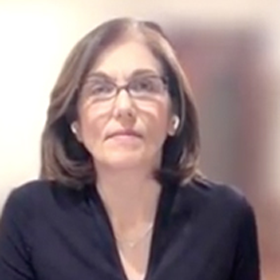Key person interview

Expectations for development of brincidofovir injection
Weill Cornell Medical School Professor
Dr. Genovéfa Papanicola
*Memorial Sloan Kettering Cancer Center was established in 1884. It is a cancer center with more than 400 beds and more than 1,000 preceptors, and is one of the 47 National Cancer Institutes (NCI) in the United States. . Consistently ranked among the top US News & World Report Best Hospitals for Cancer.
Question 1. Please tell us about the past and current status of treatment for viral infections after hematopoietic stem cell transplantation or organ transplantation.
My name is Papanicola. I am a doctor who specializes in infectious diseases. I work at Memorial Sloan Kettering Cancer Center in New York.
I originally became interested in post-transplant viral infections because this was a clinically important issue when I came to Sloan Kettering in New York 20 years ago. Prior to the widespread availability of molecular diagnostics, the diagnosis of disseminated cytomegalovirus and adenovirus infection was often made only after the patient died and then examined organs. However, in the last 10-15 years, molecular diagnostics such as quantitative PCR methods have made it possible to detect viruses present in the blood before they affect various organs.
The first major advances in monitoring and preemptive treatment were against cytomegalovirus (CMV). Compared to other double-stranded (ds) DNA viruses, the natural history of cytomegalovirus infection was well known. The availability of antiviral drugs against cytomegalovirus in the mid-1980s significantly reduced mortality. However, antiviral drugs against many other dsDNA viruses have not been successfully developed. For example, there are no antiviral drugs approved against adenovirus, BK virus, EB virus, HHV-6 virus. Therefore, even if these infections in transplant patients are diagnosed early, there is no effective treatment, and they continue to be unsatisfactory.
Taking adenovirus as an example, the mortality rate when it infects the lungs and causes pneumonia is about 90%. This mortality rate has changed little over the last 20 years, and there is no effective treatment for adenovirus.
Another problem is that many patients may be infected with not only one virus, but multiple viruses simultaneously or sequentially.
Question 2. Please tell us about your experiences with severe cases of viral infections after transplantation.
I would like to share an example of a patient I recently treated. A 65-year-old man who underwent a T-cell-depleted transplant. This patient became infected with cytomegalovirus early after transplantation. At our center, letermovir is routinely used to prevent cytomegalovirus infection. Unfortunately, this patient was infected with cytomegalovirus early after transplantation, so foscarnet, which requires intravenous administration, was used. As a result, the hospital stay was longer than usual. Cytomegalovirus was eventually controlled and transitioned to second prophylaxis with letermovir.
However, several weeks later, he developed EB viremia and was treated with rituximab. A few weeks later, adenoviral viremia developed, initially mild, but then increased in viral load. I needed treatment, but since there is no approved treatment at this stage, I decided to administer cidofovir (*), an antiviral drug, by intravenous drip.
Cidofovir has been confirmed to have activity against adenoviruses in in vitro experiments, but its in vivo activity is considered to be limited because it does not penetrate tissues where adenoviruses multiply, such as the lungs, gastrointestinal tract, and liver. . Cidofovir is a nephrotoxic drug.
Also, cidofovir is not an easy drug to administer. Although it is administered once a week, it requires hydration via IV before and after administration, and patients spend hours in the clinic. Probenecid should be used in combination with cidofovir to slow the renal excretion of cidofovir. Nephrotoxicity makes cidofovir very difficult to use in patients who may already have compromised kidney function, such as the elderly.
In the first 3 months after transplant, the patient above had 3 different infections caused by 3 different dsDNA viruses. Of course, it would be ideal to have an antiviral drug with broad-spectrum activity that is effective against all these viruses. Safety and tolerability are also important. For example, transplant patients often have pre-existing conditions or organ failure, so it is important to consider not only efficacy but also safety. Ideally, the treatment should not adversely affect the patient's quality of life. An example of a dsDNA virus that can affect quality of life is the BK virus.
The BK virus can cause hemorrhagic cystitis, and hematuria and, in severe cases, blood clots may be seen. In this case, urine flow can be blocked anywhere from the kidneys to the bladder. In such cases, hospitalization is usually required for hydration and pain management, but invasive procedures to remove blood clots may be necessary. Unfortunately, current treatments for hemorrhagic cystitis only relieve symptoms rather than address the underlying viral infection. There are currently two promising therapeutics in development against dsDNA viruses. I hope that these two treatments will be available to patients soon.
One is cell therapy, which has been in development for several years against dsDNA viruses. Patients are given virus-specific T cells that are obtained from a transplant donor or an unrelated donor and expanded in the laboratory. This cell has the ability to attack and kill viruses. Logistical issues with cell therapy include availability and treatment costs, and clinical trials are currently underway, but are still in the experimental stage. Another limitation is that cell therapy is less effective in patients receiving high-dose steroids, such as those who develop graft-versus-host disease after transplantation. The second strategy is the development of small molecule drugs against dsDNA viruses. I believe further development of brincidofovir is very important for patients.
*Cidofovir is an unapproved drug in Japan
Question 3. Please tell us about your experience with brincidofovir and your thoughts on the development of an intravenous formulation.
I have been involved in the development of an oral formulation of brincidofovir since 2010, when Chimerix had an extended access program through which we were able to treat infections with any dsDNA virus. rice field. The antiviral activity of brincidofovir was demonstrated in a compassionate youth program. We were struck by the significant reduction in viral load of all dsDNA viruses, including cytomegalovirus, adenovirus, BK virus, and HHV-6. Also, the doses of oral brincidofovir used in the compassionate youth program were rather high, which caused gastrointestinal side effects. Development of an oral formulation of brincidofovir against the ds DNA virus was discontinued because these side effects can become severe with continued use. Subsequently, an appropriate dose range was identified and, with close monitoring and dose adjustment, it could be used with caution in certain patients. However, brincidofovir cannot be widely used as an oral formulation. I think we need a different formulation. brincidofovir is a highly effective antiviral drug against many viruses, but safer formulations are needed.
Therefore, I am very excited about the development of an intravenous injection of brincidofovir, and I am closely monitoring its progress. We believe that providing an effective and safe treatment for infection by the dsDNA virus has the potential to save patients. Infection, along with graft-versus-host disease, is the leading cause of non-relapse mortality after stem cell transplantation. I am very excited about the potential for brincidofovir to reduce morbidity and mortality from dsDNA viral infections in patients.

Question 4. Recently, a paper was published suggesting that the autoimmune disease multiple sclerosis may actually be caused by the EB virus.

I read the abstract of the paper. I think it's a very interesting and exciting paper. I believe that the relationship between dsDNA viruses and human diseases will continue to be elucidated. If the results of this paper are validated, they represent a great opportunity for treatment and prevention of this serious disease.
